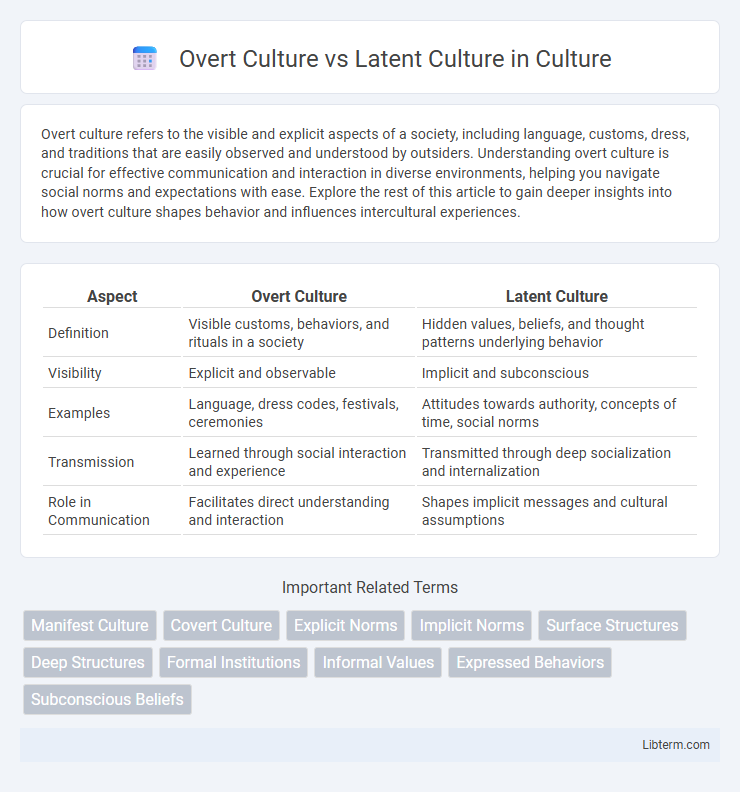Overt culture refers to the visible and explicit aspects of a society, including language, customs, dress, and traditions that are easily observed and understood by outsiders. Understanding overt culture is crucial for effective communication and interaction in diverse environments, helping you navigate social norms and expectations with ease. Explore the rest of this article to gain deeper insights into how overt culture shapes behavior and influences intercultural experiences.
Table of Comparison
| Aspect | Overt Culture | Latent Culture |
|---|---|---|
| Definition | Visible customs, behaviors, and rituals in a society | Hidden values, beliefs, and thought patterns underlying behavior |
| Visibility | Explicit and observable | Implicit and subconscious |
| Examples | Language, dress codes, festivals, ceremonies | Attitudes towards authority, concepts of time, social norms |
| Transmission | Learned through social interaction and experience | Transmitted through deep socialization and internalization |
| Role in Communication | Facilitates direct understanding and interaction | Shapes implicit messages and cultural assumptions |
Understanding Overt Culture
Overt culture encompasses the visible and tangible aspects of a society, such as language, clothing, rituals, and customs, which are easily observed and recognized by outsiders. These explicit elements serve as immediate identifiers of cultural identity and provide insight into social norms and values. Understanding overt culture is essential for effective cross-cultural communication and helps in navigating social environments by interpreting observable behaviors and symbols.
Defining Latent Culture
Latent culture refers to the underlying, unconscious values, beliefs, and assumptions that shape social behavior within a community but are not immediately visible or explicit. This hidden dimension influences attitudes, decision-making, and interpersonal interactions, often guiding actions without overt recognition. Understanding latent culture is crucial for decoding subtle social cues and fostering deeper cross-cultural communication.
Key Differences Between Overt and Latent Culture
Overt culture consists of visible, tangible cultural elements such as language, dress, food, and rituals that are easily observed and identified by outsiders. Latent culture involves the underlying beliefs, values, norms, and thought patterns that influence behavior but remain invisible or implicit within a society. Key differences between overt and latent culture lie in their observability, with overt culture being explicit and surface-level, while latent culture shapes deeper meanings and motivations behind social actions.
Manifestations of Overt Culture in Daily Life
Overt culture manifests in daily life through visible behaviors, customs, language, dress, and rituals that are easily observed by outsiders, such as traditional festivals, greetings, and social norms. These explicit cultural expressions serve as tangible indicators of a community's identity and values, shaping interactions and social cohesion. Understanding overt culture enables clearer cross-cultural communication and appreciation of observable societal patterns.
The Hidden Influence of Latent Culture
Latent culture represents the underlying values, norms, and beliefs that subtly shape behavior and social practices without being immediately visible, influencing decision-making and interpersonal interactions in profound ways. This hidden dimension of culture impacts organizational dynamics, communication patterns, and conflict resolution by driving motivations and expectations that are often unconscious. Understanding and addressing latent culture is essential for effective cross-cultural communication and fostering inclusive environments that respect deeper cultural nuances.
The Role of Social Norms in Each Culture Type
Social norms in overt culture are explicit and clearly communicated, guiding observable behaviors and practices within a society. In latent culture, social norms remain implicit, shaping underlying values, beliefs, and attitudes that influence behavior subconsciously. Understanding the distinction helps in analyzing how social expectations govern interactions either through visible rules or subtle, unspoken cues.
Overt vs Latent Culture in Organizational Settings
Overt culture in organizational settings refers to visible, explicit elements such as dress codes, office layouts, and formal policies that employees can easily observe and follow. Latent culture encompasses underlying values, beliefs, and assumptions that are not immediately visible but significantly influence decision-making, communication styles, and workplace behavior. Understanding both overt and latent culture is essential for effective leadership, as it enables managers to address surface-level practices while also navigating deep-rooted organizational dynamics.
Impacts on Communication and Behavior
Overt culture encompasses visible symbols, language, and customs that directly shape communication styles and social interactions, fostering immediate understanding through shared tangible elements. Latent culture includes underlying values, beliefs, and thought patterns that subtly influence behavior and interpretation, often causing misunderstandings in cross-cultural communication when unrecognized. The interplay between overt and latent culture determines the effectiveness of interpersonal communication and the potential for behavioral misalignment in multicultural environments.
Navigating Cultural Misunderstandings
Navigating cultural misunderstandings requires distinguishing overt culture--observable behaviors, customs, and language--from latent culture, which includes underlying values, beliefs, and thought patterns. Misinterpretations often arise when individuals focus solely on overt culture without recognizing latent cultural norms that influence actions and communication styles. Developing cultural competence entails understanding both visible and hidden cultural elements to enhance cross-cultural interactions and reduce conflicts.
Integrating Overt and Latent Cultural Awareness
Integrating overt and latent cultural awareness enhances cross-cultural communication by recognizing both explicit behaviors and underlying values shaping social interactions. Organizations that effectively combine observable cultural traits with deeper, less visible norms foster inclusive environments and reduce misunderstandings. Emphasizing this integration supports adaptive strategies in global teamwork and multicultural negotiation contexts.
Overt Culture Infographic

 libterm.com
libterm.com